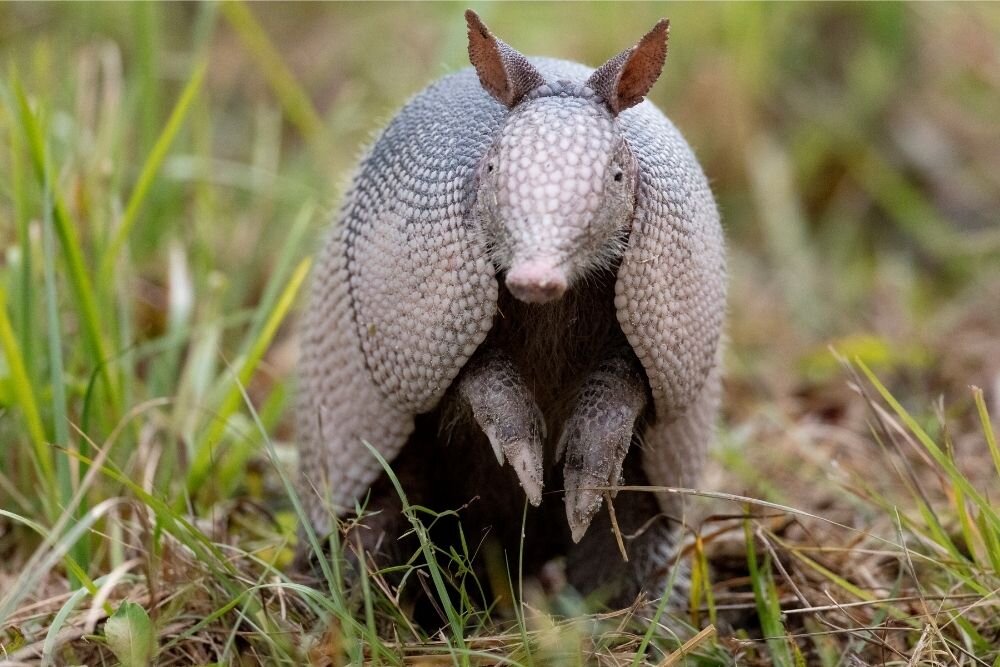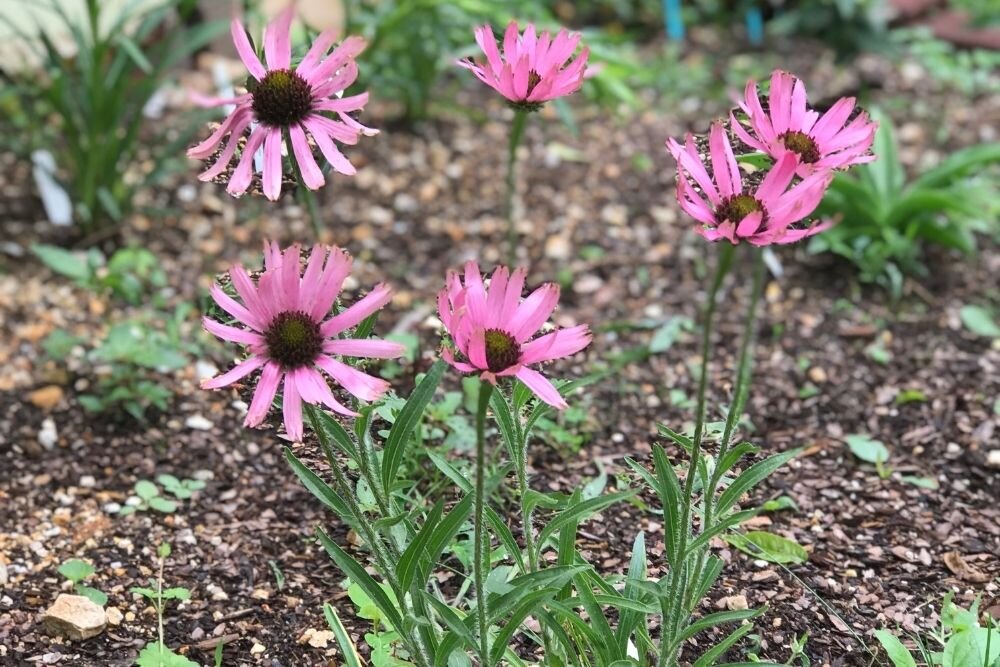
Meet Phoebe, Our Virginia Opossum
Reflection Riding has a new member of the family! Meet Phoebe, our Virginia Opossum. Phoebe was born in early spring 2021 and arrived at Reflection Riding just recently after being cared for by the wonderful caregivers at Opie Acres, Chattanooga’s opossum rehabilitation group.

Swamp White Oak
Swamp White Oak – Quercus bicolor – is a deciduous, medium-tall tree from the Beech (Fagaceae) family. As an oak, this tree falls into another category as the number one Genus for supporting Lepidoptera (butterflies and moth) and is critical to supporting declining species in that Genus, not to mention many bird species that depend on Lepidoptera for their food.

Slender Mountain Mint
Slender Mountain Mint – (Pycnanthemum virginianum) is an herbaceous, fragrant perennial and is a member of the Mint (Lamiaceae) family. It is a garden workhorse, producing prolific blooms for pollinators and you to enjoy.

Garden Phlox
Garden Phlox – Phlox paniculata – prized for its billows of sweetly fragrant blooms, should be a staple for anyone desiring long-lasting, trouble-free garden color in the mid-summer months. This plant is particularly appealing to butterflies and hummingbirds and also tolerates grazing by deer.

Behold, the Armadillo!
Surprising to some, many of us have seen armadillos in our immediate area. These unusual looking animals have only reached Tennessee in the last thirty years or so, but their potential range continues to expand because of their rapid breeding cycle, adaptability, reduction of predators, and climate warming caused by increasing carbon in the atmosphere.

Tickseed (Coreopsis)
Tickseed – Coreopsis spp.- is a massive genus with many species and many cultivars and varieties within those species. It is a member of the Aster (Asteraceae) family, is perennial (sometimes annual), and native to all of the Americas; North, Central and South America.
Coreopsis provides a superb ground cover for yards as well as a cover for denuded or eroded areas.

Small Whorled Pogonia
“The Rarest Orchid East of the Mississippi” and the Importance of Finding It
How can any plant be rare when we see a mosaic of green everywhere we look? Well, according to the U.S. Forest Service, 8,500+ species, or one third of our native plants, are considered to be rare in the United States. In recent field work, Dylan Hackett and Scotty Smith, with the help of Zach Irick from SGI and Hannah Lieffring, set out to find the elusive Small Whorled Pogonia (Isotria medeoloides), considered the rarest orchid east of the Mississippi. There have been only three observed and recorded populations in Tennessee, one of which is in Hamilton County.

Bottlebrush Buckeye
Bottlebrush Buckeye – Aesculus parviflora - is a member of the soapberry family (Sapindaceae), which used to be the horse-chestnut family. Its genus name, Aesculus, is the same as that for the common American horse-chestnut. Few large shrubs/small trees are as well suited for your lawn as this.

Arrowwood Viburnum
Arrowwood Viburnum – Viburnum dentatum – is a native shrub species found throughout the eastern portion of the United States from hardiness zones 2 through 8. It grows to a mature height of 6 to 15 feet and is deciduous. The common name for this species comes from Native Americans, who used the straight stems of the plant as arrows.

Framework for the Future Makes a Splash
Developed from fall 2020 to spring 2021, the Framework draws together detailed input and aspirations from over 800 participants including staff, board members, volunteers, nearby residents, and community members, creating a guide for the future while preserving and expanding current programs.

Pennsylvania Sedge
Pennsylvania Sedge – Carex pensylvanica – is a highly variable native member of the Sedge (Cyperaceae) family and is widely distributed, growing in woods, woodland openings, and thickets, on upland organic soils in average to dry conditions, over much of eastern North America. While this is a flowering plant, its blossom is rather insignificant and has no fragrance. It is one of the most sought-after perennial groundcovers in the horticulture trade.

Annual Report June 2021
As we think back over the last year, it’s hard to believe how far Reflection Riding has come. We are incredibly proud of this work and how well it has positioned Reflection Riding for the future. Your support made it possible.

Cumberland Rosemary
Cumberland Rosemary – Conradina verticillata – is a deciduous, perennial short shrub and a member of the Mint (Lamiaceae) family. Currently, this species is on both the Tennessee and federal protection lists classified as Threatened. However, a variety is propagated commercially and, therefore, can be grown in our gardens. Cumberland Rosemary is only found in the wild in Kentucky and Tennessee. Wild specimens are protected because of habitat destruction.

Red Wolf Pups Born at Reflection Riding
Reflection Riding is very excited to announce the birth of two critically-endangered red wolf pups to parents, Apollo and Ruby, on April 15, 2021. These pups, Romulus and Remus, represent hope and excitement for the entire red wolf population, and they are being cared for here at Reflection Riding, where they were born. This news is incredibly exciting, as fewer than 250 American red wolves exist today, with very few in the wild.

Tennessee Coneflower
Tennessee coneflower (Echinacea tennesseensis) is a perennial member of the Aster Family (Asteraceae) and is easily grown in medium moist, well-drained soil in full sun. This is perhaps the best of all the coneflowers for home gardens because its shorter habit keeps it from flopping over, and its blooms dry beautifully in place, holding most of their color.

Sweetbay Magnolia
The Sweetbay Magnolia (Magnolia virginiana) is indigenous to the eastern half of North America, especially along the Atlantic and Gulf coasts from Massachusetts to Texas. It is a stately tree and would be a beautiful addition to most suitable gardens as a specimen plant.

Fringe Tree
Fringe Tree - Chinoanthus virginicus - is a native, perennial, deciduous, hardy shrub or short tree with showy, fragrant, creamy-white flowers forming from May to June. It is a member of the olive (Oleacea) family. It grows to a height of 12 to 20 feet tall and with a similar width. It grows well in full sun to partial shade in a moist, well-drained soil. It prefers moist stream banks, hillsides, rocky bluffs and moist glades. The flowers of this species are an inch long and 1/16 inch wide, and they hang in show-stopping branched clusters 4 to 6 inches long.

The Association of Nature Center Administrators Honors Mark McKnight with 2021 ANCA Outstanding New Leader Award
The Association of Nature Center Administrators (ANCA) is pleased to announce Mark McKnight as recipient of the 2021 ANCA Outstanding New Leader Award.


Yellowwood
Yellowwood – Cladrastis kentukea - This small to medium sized tree is a member of the pea (or Fabaceae) family. Because of its striking flowers in the spring and its eye-catching foliage in the autumn, American yellowwood is a good selection for a specimen tree to add interest to any garden.

